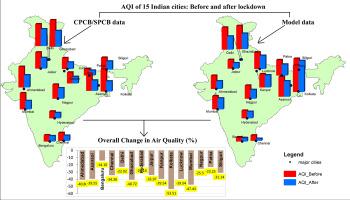Urban Climate ( IF 6.4 ) Pub Date : 2021-02-12 , DOI: 10.1016/j.uclim.2021.100802 Saidur Rahaman 1 , Selim Jahangir 2 , Ruishan Chen 1 , Pankaj Kumar 3 , Swati Thakur 4

|
The complete lockdown due to COVID-19 pandemic has contributed to the improvement of air quality across the countries particularly in developing countries including India. This study aims to assess the air quality by monitoring major atmospheric pollutants such as AOD, CO, PM2.5, NO2, O3 and SO2 in 15 major cities of India using Air Quality Zonal Modeling. The study is based on two different data sources; (a) grid data (MODIS- Terra, MERRA-2, OMI and AIRS, Global Modeling and Assimilation Office, NASA) and (b) ground monitoring station data provided by Central Pollution Control Board (CPCB) / State Pollution Control Board (SPCB). The remotely sensed data demonstrated that the concentration of PM2.5 has declined by 14%, about 30% of NO2 in million-plus cities, 2.06% CO, SO2 within the range of 5 to 60%, whereas the concentration of O3 has increased by 1 to 3% in majority of cities compared with pre lockdown. On the other hand, CPCB/SPCB data showed more than 40% decrease in PM2.5 and 47% decrease in PM10 in north Indian cities, more than 35% decrease in NO2 in metropolitan cities, more than 85% decrease in SO2 in Chennai and Nagpur and more than 17% increase in O3 in five cities amid 43 days pandemic lockdown. The restrictions of anthropogenic activities have substantial effect on the emission of primary atmospheric pollutants.



























 京公网安备 11010802027423号
京公网安备 11010802027423号